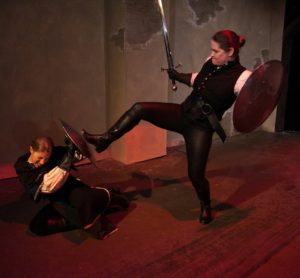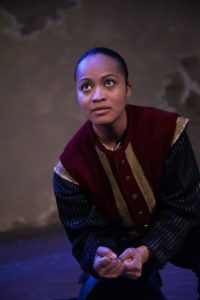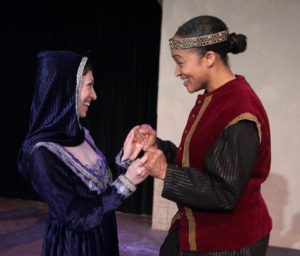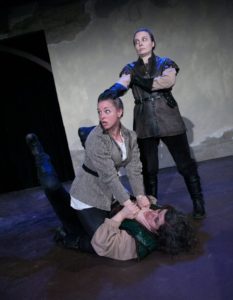
Chelsea Rolfes as a French Soldier and Delia Ford as Exeter. Costumes by Rachel Sypniewski. Lighting by Andrea Trygstad. Photo by Johnny Knight.
Right off the top, I must say: I cannot remember the last time I saw a Shakespeare play where so many actors knew what they were saying and why they were saying it. Shakespeare is done to death because it is free and has a built-in audience, and yet so few theater companies pay any attention to the words they are saying, how sentences are structured, or what these sentences even mean. I find this failing consistently throughout Shakespearean theater, whether it be in high school productions or the highest echelons of local art. This rare exception was a genuine treat.
[tl;dr – Henry V has strong energy, quality production values, and is excellently paced. Diana Coates’ Henry carries the show beautifully with charisma and energy. Though tactics- and characterization-wise she is a a bit of a one-trick pony, there’s no question that she was the actor needed to drive this show. Costuming and staging are traditional, which is very welcome to me. Extra kudos goes to Alison Vodnoy Wolf for her physically, vocally, and energetically diverse portrayal of different characters, and to Samantha Kaufman for her smoothly smarmy Dauphin. Kim Fukawa’s violence stands out for breadth, clarity, and intensity in a city full of violence specialists. This production is well worth your time and money. You can read my other reviews here.]
Of course, Babes with Blades has another vital use for Shakespeare plays besides their economic efficiency: sword fights. Strictly ‘traditional’ gender-casting typically casts women as the victims of violence, regardless of the theatrical era, and this company is founded upon using staged violence to help empower women actors and characters. I mention this because, for a company so dedicated to stage violence to take the time to understand verse (again, something that happens very rarely in my experience and observation), is doubly worthy of admiration. I found no dramaturge or verse coach listed in the show’s program, so I assume this accomplishment rested largely on the shoulders of director Hayley Rice (and the actors, of course), to whom I am immensely grateful. And frankly, even if the rest of the show had been utter garbage (which it decidedly was not), this alone would have made it well worth my time.

Diana Coates as Henry. Costumes by Rachel Sypniewski. Lighting by Andrea Trygstad. Photo by Johnny Knight.
This particular Henry V is staged in City Lit’s open, expansive semi-thrust space, ideal for presentational acting that seeks to draw an audience in. Whether for budget or effect, the space is wisely uncluttered with redundant bric-a-brac, the walls themselves being the primary environmental art (used to effect by the Chorus at the play’s opening, but more on that later). Small moveables are used throughout both practically and for decoration, and it should come as little surprise that each set piece is simple, beautiful, and internally consistent (thanks to designer Elyse Balogh), while contrasting charmingly but not glaringly with the outer-most set that established the frame tale of this production.
Said frame tale sets us in a rundown classroom of sorts: the walls are dilapidated and peeling, and a transparency projector sits at the far edge of where the stage and audience meets. The Chorus enters at open, examines with overt exasperation the poor quality of the classroom, then speaks the famous Muse of Fire speech, which apologizes that our theater is insufficient for the sweeping and epic drama that is about to unfold. Although I don’t think this framing device adds much to the story per se (though it does allow a brief and knowing smirk regarding the quality of our current education system, to those who wish to interpret it so), it certainly doesn’t overwhelm or detract. Contemporary Shakespeare is so awash in needless concepts and cumbersome add-ons that smaller embellishments are very welcome.
Same goes for the high quality costuming by Rachel Sypniewski. Shakespeare’s war plays are often draped in modern fatigues, presumably to justify a shoestring budget with the illusion of an overdone commentary on the timelessness of war; but if there was ever a Shakespearean war play that justified the pageantry of Elizabethan-esque costuming, it is this largely rose-glassed love letter to one of England’s most beloved unofficial patron saints. Sypniewski’s costumes are well executed and representative throughout: the usual red-versus-blue is established without being obnoxious or overwhelming, rank is clearly indicated by fabric and color (or lack of color), and Hal’s unusually dark costume palette, relatively light on gold, perhaps helps to highlight the rare instances of evil that appear in one of Shakespeare’s most populist plays.

Alison Vodnoy Wolf as Catherine, and Diana Coates as Henry. Costumes by Rachel Sypniewski. Lighting by Andrea Trygstad. Photo by Johnny Knight.
So: the play. Chelsea Rolfes’ Chorus immediately sets a high bar with clear vocal quality and energized delivery, providing strong motivation (and/or clear impulses) for every clause she speaks. This bar proved to be met and occasionally exceeded by virtually all actors. Rolfes’ Chorus, dressed as a school teacher, is aided with the aforesaid transparency projector, presumably to help the audience follow the convoluted and garbled history of British royalty. The concept was unique, but it seemed to me like an apology: either for the script, which we must assume the director loves as she is directing it; or for the actor, whose physical and vocal clarity required no apology; or for the audience, who perhaps were assumed to be too uninformed, uneducated, or un-capable of following the inner mysteries of English heraldry. This last point might have some justification, but audiences (myself included) have been misunderstanding or just plain dismissing the complexities of succession and conquest for centuries, with little adverse effect on the popularity of Henry V.
This conceptualization (which I hasten to repeat, is thankfully far subtler and light-handed than in most Shakespeare plays) finds its heaviest moment in one of my favorite characters, that unsung hero of the comedic canon: the Bishop of Canterbury. Though a bit un-animated for my tastes (and, to be fair, this is a bishop we’re talking about), Jennifer L. Mickelson’s Canterbury is an articulate and natural embodiment of a stuffy authority figure. In one of the greatest examples of too-much-build-up for a punchline that’s only funny because of too-much-build-up, Canterbury presents a famously long-winded, convoluted, and indecipherable speech justifying the invasion of France. Visual aids from the transparency projector highlighted this confusion and scored many laughs, but I can’t help feeling that a skilled actor, un-hobbled by this crutch, could have scored the same laughs on her own. This reached a head at the comedic climax of the speech, where the mere turning off of a projector elicited such a response that it completely drowned out Mickelson’s delivery of the actual punchline. All the same, I should remember that this conceptualization still made the speech very funny, which was the point. This sort of hand-holding so overwhelms most Shakespeare productions, that it seems almost unique and calculated in Babes’ Henry V; though it still seems to betray a lack of confidence in the audience, the actors, or perhaps the script itself.

Jennifer L. Mickelson as Gower, Alexis Randolph as Michael Williams, and Morgan Manasa as Fluellen. Violence by Kim Fukawa. Costumes by Rachel Sypniewski. Lighting by Andrea Trygstad. Photo by Johnny Knight.
But enough of my personal literary crusades. This conceptualization quickly fades into the background with Canterbury’s completion, and the show becomes unquestionably Henry’s. In the title role, Diana Coates carries this play as a giant among giants without flagging or failing in her commitment and energy. With a Branaugh-esque veneer of confidence (not necessarily a bad thing), combined with a cleverness and awareness found in more accessible embodiments of Hamlet, Coates powers through this juggernaut of a role with apparent ease and facility, punching or shrugging as necessary and without once even stumbling under the responsibility.
Although her impulses were consistently empowered, Coates’ Henry seemed to be consistently hiding from us. There was so much of the regal, so much of the charismatic and declamatory, that I spent much of my time hoping for the real Hal to eventually emerge from this compelling facade. In this, I was disappointed. Although occasional moments of vulnerability did emerge, they were only to be found in a few silences between lines; that, or occasionally vaulted up to, as though trying to achieve a higher sincerity through force, rather than opening up (or discarding) the princely armor. The snag of it, is that so many of Hal’s scenes can justify this veneer, should we so choose, that it is difficult to fault Coates for so consistently using the same tactics, despite the fact that this sometimes smacks of superficiality.
Of course, it’s easy to criticize an actor when she is so long onstage, carrying so much of the action, and so frequently open to scrutiny. And the consistency of this veneer in a lead character means that director Rice must share at least some of the responsibility for that interpretation. Nevertheless, even in a cast full of energized, articulated, and well-paced performances, there is still no question that Coates was the right choice: she possessed and presented so much of the drive, the charisma, and the power needed to make this show a success, that even now I have trouble imagining many actors who could, not only handle that burden, but succeed with it. It should also be mentioned that the famous staples of “Once more unto the breach” and the St. Crispin’s Day speech held their own subtleties, with the Breach permitting some welcomed moments of uncertainty and Crispin including delightful moments of direct address.

Kim Fukawa as the Constable, and Samantha Kaufman as the Dauphin. Costumes by Rachel Sypniewski. Lighting by Andrea Trygstad. Photo by Johnny Knight.
Although every actor in this production is worthy of praise, special mention goes to Alison Vodnoy Wolf and Samantha Kaufman. Wolf’s diverse characterizations were particularly strong, altering her centering, pacing, and direction of energy to create starkly contrasting characters. Kaufman’s Dauphin was delightfully French and smarmily, smoothly amusing in his confidence, making smart use of the “Frenchness” that underpins this play, without relying on the cliches of emasculation that so frequently color Shakespeare’s Dauphins.
Babes with Blades’ Henry was well-paced, well-produced, and far more importantly in my eyes: it featured informed and articulated performances. I should add in ironic parentheses, that Kim Fukawa’s violence is dynamically compelling both in the grand alarums and in its more intimate moments. Staged violence is what Babes with Blades does, and Hal’s war did not disappoint.
Henry V runs until April 1st at City Lit’s space. It is well worth your $20 and your time. More information can be found here.
Shakespeare!
